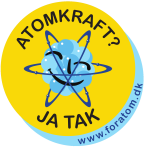It is often emphasized that the spent fuel will be dangerous for hundreds of thousands of years with reference to the half-life. But this is based on a misunderstanding of both risk assessment and radioactivity.
Is using fuel a risk?
Since the beginning of civil nuclear power, the spent fuel to date has never harmed or cost a single human life. Just as it has not harmed our planet [1].
This is in contrast to fossil energy and biomass, where the waste via air pollution worldwide costs 9 million human lives annually. As well as emitting greenhouse gases that change our climate. As well as a lot of other industrial waste.
The spent fuel from civil nuclear power is therefore not dangerous because it is regulated and handled so that it poses no threat to human health or the biosphere.
Half-life – what does it mean?
The half-life is often confused with “dangerous radioactivity”. It is based on a fundamental misunderstanding that radioactive materials emit a constant amount of radiation during this half-life.
The half-life is defined as the time it takes for a radioactive substance to be reduced by half. It decreases or decays as it is called.
It is the case that higher radioactivity equals a shorter half-life and vice versa. Radioactive materials are not dangerous because they have long half-lives, in fact the other way around. carbon-14 has a half-life of a whopping 5,730 years. But is nevertheless a useful, radioactive and harmless part of every human body [2]. Carbon 14 dating is also used to date an object [3].
How radioactive is the spent fuel?
Freshly taken out of the reactor, the fuel is rich in fission products with very short half-lives. Thus, much of the radioactivity occurs in the first weeks, hours or even seconds after. It happens safely in the cooling basin. Approx. 40 years after the spent fuel is removed from the reactor, the activity has decreased by about 99% [4]. As shown in figure.1 below.
It is unlike most other non-radioactive elements around the world. They are extremely toxic and do not lose their toxicity over time but last forever. This applies to Lead, Cadmium, Arsenic and Mercury. Which makes nuclear power unique.

Sources:




